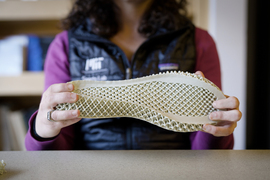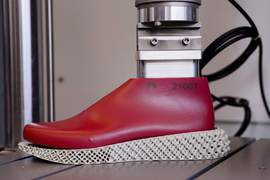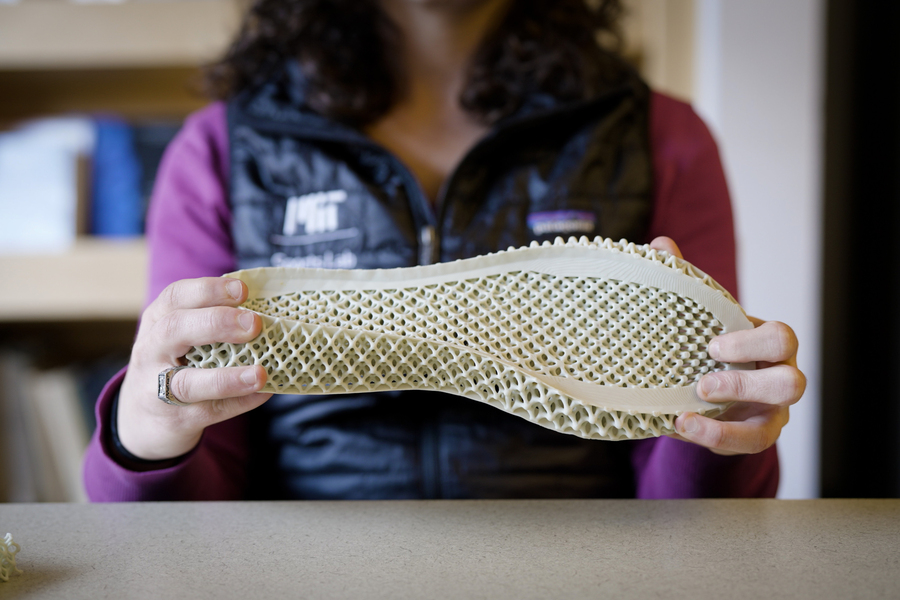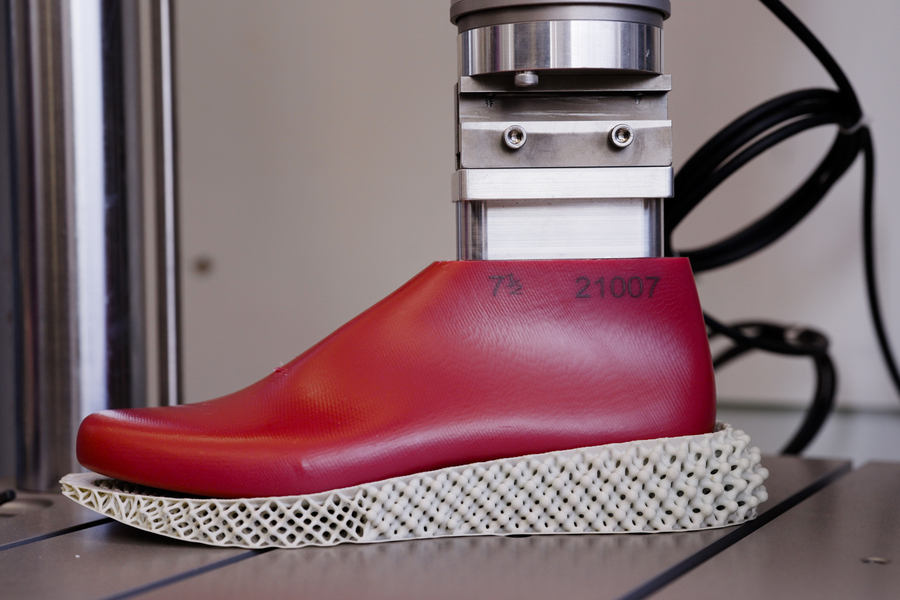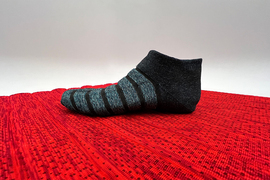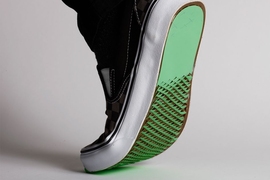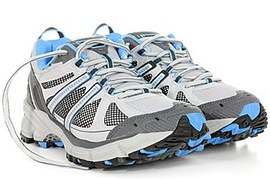A good shoe can make a huge difference for runners, from career marathoners to couch-to-5K first-timers. But every runner is unique, and a shoe that works for one might trip up another. Outside of trying on a rack of different designs, there’s no quick and easy way to know which shoe best suits a person’s particular running style.
MIT engineers are hoping to change that with a new model that predicts how certain shoe properties will affect a runner’s performance.
The simple model incorporates a person’s height, weight, and other general dimensions, along with shoe properties such as stiffness and springiness along the midsole. With this input, the model then simulates a person’s running gait, or how they would run, in a particular shoe.
Using the model, the researchers can simulate how a runner’s gait changes with different shoe types. They can then pick out the shoe that produces the best performance, which they define as the degree to which a runner’s expended energy is minimized.
While the model can accurately simulate changes in a runner’s gait when comparing two very different shoe types, it is less discerning when comparing relatively similar designs, including most commercially available running shoes. For this reason, the researchers envision the current model would be best used as a tool for shoe designers looking to push the boundaries of sneaker design.
“Shoe designers are starting to 3D print shoes, meaning they can now make them with a much wider range of properties than with just a regular slab of foam,” says Sarah Fay, a postdoc in MIT’s Sports Lab and the Institute for Data, Systems, and Society (IDSS). “Our model could help them design really novel shoes that are also high-performing.”
The team is planning to improve the model, in hopes that consumers can one day use a similar version to pick shoes that fit their personal running style.
“We’ve allowed for enough flexibility in the model that it can be used to design custom shoes and understand different individual behaviors,” Fay says. “Way down the road, we imagine that if you send us a video of yourself running, we could 3D print the shoe that’s right for you. That would be the moonshot.”
The new model is reported in a study appearing this month in the Journal of Biomechanical Engineering. The study is authored by Fay and Anette “Peko” Hosoi, professor of mechanical engineering at MIT.
Running, revamped
The team’s new model grew out of talks with collaborators in the sneaker industry, where designers have started to 3D print shoes at commercial scale. These designs incorporate 3D-printed midsoles that resemble intricate scaffolds, the geometry of which can be tailored to give a certain bounce or stiffness in specific locations across the sole.
“With 3D printing, designers can tune everything about the material response locally,” Hosoi says. “And they came to us and essentially said, ‘We can do all these things. What should we do?’”
“Part of the design problem is to predict what a runner will do when you put an entirely new shoe on them,” Fay adds. “You have to couple the dynamics of the runner with the properties of the shoe.”
Fay and Hosoi looked first to represent a runner’s dynamics using a simple model. They drew inspiration from Thomas McMahon, a leader in the study of biomechanics at Harvard University, who in the 1970s used a very simple “spring and damper” model to model a runner’s essential gait mechanics. Using this gait model, he predicted how fast a person could run on various track types, from traditional concrete surfaces to more rubbery material. The model showed that runners should run faster on softer, bouncier tracks that supported a runner’s natural gait.
Though this may be unsurprising today, the insight was a revelation at the time, prompting Harvard to revamp its indoor track — a move that quickly accumulated track records, as runners found they could run much faster on the softier, springier surface.
“McMahon’s work showed that, even if we don’t model every single limb and muscle and component of the human body, we’re still able to create meaningful insights in terms of how we design for athletic performance,” Fay says.
Gait cost
Following McMahon’s lead, Fay and Hosoi developed a similar, simplified model of a runner’s dynamics. The model represents a runner as a center of mass, with a hip that can rotate and a leg that can stretch. The leg is connected to a box-like shoe, with springiness and shock absorption that can be tuned, both vertically and horizontally.
They reasoned that they should be able to input into the model a person’s basic dimensions, such as their height, weight, and leg length, along with a shoe’s material properties, such as the stiffness of the front and back midsole, and use the model to simulate what a person’s gait is likely to be when running in that shoe.
But they also realized that a person’s gait can depend on a less definable property, which they call the “biological cost function” — a quality that a runner might not consciously be aware of but nevertheless may try to minimize whenever they run. The team reasoned that if they can identify a biological cost function that is general to most runners, then they might predict not only a person’s gait for a given shoe but also which shoe produces the gait corresponding to the best running performance.
With this in mind, the team looked to a previous treadmill study, which recorded detailed measurements of runners, such as the force of their impacts, the angle and motion of their joints, the spring in their steps, and the work of their muscles as they ran, each in the same type of running shoe.
Fay and Hosoi hypothesized that each runner’s actual gait arose not only from their personal dimensions and shoe properties, but also a subconscious goal to minimize one or more biological measures, yet unknown. To reveal these measures, the team used their model to simulate each runner’s gait multiple times. Each time, they programmed the model to assume the runner minimized a different biological cost, such as the degree to which they swing their leg or the impact that they make with the treadmill. They then compared the modeled gait with the runner’s actual gait to see which modeled gait — and assumed cost — matched the actual gait.
In the end, the team found that most runners tend to minimize two costs: the impact their feet make with the treadmill and the amount of energy their legs expend.
“If we tell our model, ‘Optimize your gait on these two things,’ it gives us really realistic-looking gaits that best match the data we have,” Fay explains. “This gives us confidence that the model can predict how people will actually run, even if we change their shoe.”
As a final step, the researchers simulated a wide range of shoe styles and used the model to predict a runner’s gait and how efficient each gait would be for a given type of shoe.
“In some ways, this gives you a quantitative way to design a shoe for a 10K versus a marathon shoe,” Hosoi says. “Designers have an intuitive sense for that. But now we have a mathematical understanding that we hope designers can use as a tool to kickstart new ideas.”
This research is supported, in part, by adidas.
